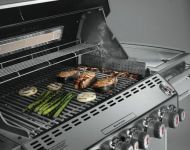In the realm of outdoor cooking, propane grills hold a special place for enthusiasts and casual grillers alike. Their convenience, ease of use, and quick heating times make them a go-to choice for those looking to cook up a delicious meal under the open sky. However, amidst the sizzle and smoke, a critical question often arises: Do propane grills produce carbon monoxide?
It’s essential to note that ALL types of grills, whether propane, charcoal, or wood-fired, can produce carbon monoxide (CO) during the combustion process. This blog dives into the specifics of propane grills, shedding light on their operation and the potential risks involved, with the aim of ensuring your grilling experience is both enjoyable and safe.
Understanding Propane Grills
Propane grills operate by burning propane gas to generate heat. Compared to their charcoal and electric counterparts, propane grills are prized for their ability to offer immediate heat control, cleanliness (with minimal ash production), and the convenience of not needing a power outlet. These factors contribute to their popularity among outdoor cooking aficionados.
What Is Carbon Monoxide?
Carbon monoxide is a colorless, odorless gas produced by the incomplete combustion of carbon-containing materials. It is dangerous because it interferes with the blood’s ability to carry oxygen, potentially leading to serious health issues or even death in high concentrations. Understanding how and why CO is produced is crucial for anyone using combustion-based cooking methods.
Do Propane Grills Produce Carbon Monoxide?
The short answer is yes, propane grills can produce carbon monoxide, particularly if the combustion process is incomplete. This incomplete combustion can occur if the grill is improperly adjusted, dirty, or if there’s insufficient airflow. While propane burns cleaner than many other fuels, it’s still imperative to ensure that it combusts completely to minimize CO production.
Safety Tips for Using Propane Grills
Ensuring Proper Ventilation
Always use propane grills outdoors in well-ventilated areas to prevent CO buildup. Enclosed spaces can trap carbon monoxide, increasing the risk of poisoning.
Regular Maintenance and Inspection
Keep your grill clean and check regularly for any signs of wear and tear, especially in the gas lines and burners. A well-maintained grill is more likely to burn efficiently, reducing the risk of CO production.
Use Outdoors Only
Never use propane grills indoors or in enclosed spaces. Even semi-enclosed spaces, like garages with the door open, can accumulate dangerous levels of CO.
Recognizing Improper Combustion
Be vigilant for signs of improper combustion, such as yellow or orange flames (instead of blue with yellow tips) and soot production. These can indicate that the fuel isn’t burning completely.
Carbon Monoxide Poisoning: Signs and Prevention
Symptoms of CO poisoning include headache, dizziness, weakness, upset stomach, vomiting, chest pain, and confusion. If you or someone else experiences these symptoms, it’s critical to get into fresh air immediately and seek medical attention. Preventive measures include using a CO detector nearby when grilling and ensuring that the grill is properly maintained and used according to the manufacturer’s instructions.
To learn more, read the CDC’s explainer on carbon monoxide poisoning.
Conclusion
While propane grills are a convenient option for outdoor cooking, it’s important to be aware that they can produce carbon monoxide if not used correctly. By understanding the combustion process and adhering to safety practices, you can enjoy the benefits of grilling while minimizing the risks. Remember, safety first ensures that the joy of grilling is shared with friends and family, not the hazards.
Stay safe and grill on!

